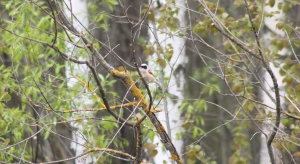Eurasian Penduline Tit (Remiz pendulinus)
The social organisation of the Penduline Tit revolves around these amazing structures. They are made up entirely of plant fibres and down, and hang suspended from the end of a branch of a tree or thicket, usually 1-10m above the water. They are domed in shape, but have a downward-facing tube-like extension on one side, near the top, which acts as the entrance lobby. When constructing the nest, the builders begin by attaching a strong loop of plant fibre underneath the branch tip, and then build out the sides. Plant fibres used include those of nettles and grass, and they are compacted into shape by plant down, giving the overall structure a felt-like feel. More plant down is stuffed inside.
The act of making a nest is the only time when the relationship between male and female Penduline Tits is sustained. They build nests together – often with one working on the outside and the other on the interior – and that’s about it, a two-week fling. They don’t co-operate in bringing up the young, but one or the other takes sole charge. Who it is depends on the bewildering sexual politics of the species. Males are sometimes polygynous, each with several mates with whom they share nest building and contribute genetic material; the most successful male birds, the ones that attract most females to their partially completed nests, are those whose structures are least infested with parasites such as mites. Females are regularly polyandrous, building with and then copulating with a succession of relatively “clean” males. There are records, for example, of female Penduline Tits having six partners in a season, with each whom they will build a nest, and for whom they might lay a clutch of eggs to incubate. Other females incubate their first clutch themselves and stick to having one partner, notwithstanding the fact that the partner himself may be building a nest with another female at the same time. Few birds have such a convoluted breeding system.

